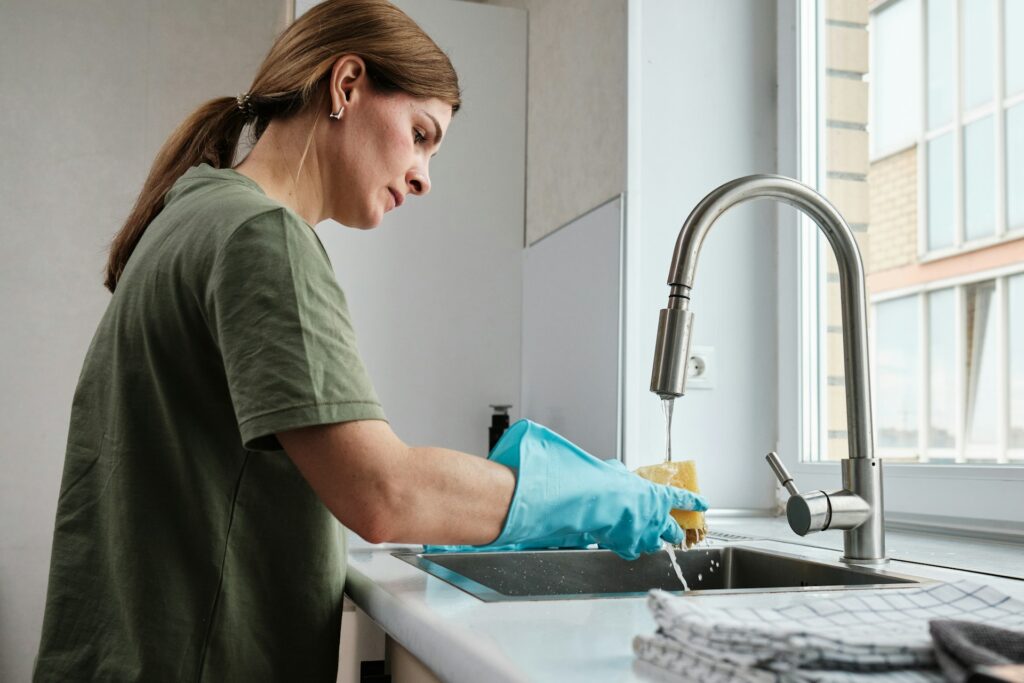Keeping a kitchen germ-free is essential for the health and safety of your family. Germs can spread easily in this room, especially where food is prepared and stored. With a few straightforward habits, you can maintain a clean and sanitary kitchen environment.
Daily Cleaning Habits for a Germ-Free Kitchen
Maintaining a germ-free kitchen starts with developing good daily cleaning habits. One of the simplest habits to adopt is wiping down countertops and surfaces after every meal preparation. Use a clean, damp cloth or a disinfectant wipe to remove food particles and spills. This quick step helps prevent the growth of bacteria and keeps surfaces clean.
Another important habit is washing dishes immediately after use. Dirty dishes left in the sink can accumulate bacteria and attract pests. Make it a practice to wash dishes, utensils, and cookware right after meals. If you use a dishwasher, make sure to run it regularly and empty it promptly to avoid any lingering odors or germs.
Also, don’t forget to clean your sink and faucet daily. After washing the dishes, scrub the sink with a mild cleaner and rinse it well. Pay special attention to the faucet handles, as they are often touched with dirty hands and can harbor germs. A clean sink provides a healthier environment for dishwashing and food preparation.
Using Safe and Effective Cleaning Products
Choosing the right cleaning products plays a significant role in keeping your kitchen germ-free. Many common cleaning solutions contain harsh chemicals that can be harmful to both your health and the environment. It’s important to select products that are safe and effective for kitchen use.
Look for cleaning products labeled as non-toxic and environmentally friendly. These products often use natural ingredients that are just as effective at killing germs without the harmful side effects. Vinegar and baking soda, for example, can be powerful cleaners for various kitchen surfaces when used correctly.
In addition to the products themselves, consider using tools that enhance cleaning effectiveness. Microfiber cloths are excellent for trapping dust and germs, and they can be used with just water for basic cleaning tasks. For tougher jobs, a mix of detergent and warm water can often do the trick.
Moreover, always read and follow the instructions on cleaning product labels. Using too much or too little can reduce their effectiveness. By using safe and effective cleaning products correctly, you can maintain a clean and healthy kitchen without unnecessary risks.
Proper Food Storage and Handling
Properly storing and handling food can prevent germs and bacteria from spreading in your kitchen. Following safe practices ensures that your food stays fresh and reduces the risk of foodborne illnesses.
Refrigeration
Store perishable items like meat, dairy, and leftovers in the refrigerator. Keep your fridge at or below 40°F. Arrange your fridge so that raw meat is on the bottom shelf to prevent juices from dripping on other food. Use airtight containers to store leftovers and label them with the date to keep track of freshness.
Dry Goods
Store dry goods like pasta, rice, and cereal in airtight containers. This prevents contamination from pests and keeps food fresher for longer. Ensure that you regularly check expiration dates and follow the “first in, first out” rule – use older items first before opening new ones.
Handling
Always wash your hands before and after handling food. Use separate cutting boards for raw meat and vegetables to avoid cross-contamination. Wash utensils and surfaces that have come into contact with raw food thoroughly with hot soapy water before using them again.
Deep Cleaning Tips for Kitchen Appliances
Deep cleaning your kitchen appliances ensures they function properly and remain hygienic. Regular deep cleaning can also prolong the life of your appliances, making your kitchen a safer place to prepare food.
Refrigerator
Empty your refrigerator of all contents and remove shelves and drawers for cleaning. Use a mixture of warm water and mild dish soap to wipe down the interior. Pay special attention to spills and sticky spots. Clean the removable parts and let them dry completely before putting them back. Don’t forget to clean the door seals, where mold and bacteria can easily grow.
Oven and Stove
Use a store-bought oven cleaner or a homemade mixture of baking soda and water to clean the inside of your oven. Let it sit for several hours or overnight, then scrub and wipe clean. For the stovetop, remove burner grates and drip pans and soak them in soapy water. Scrub the stovetop surface to remove grease and food residue. Clean control knobs and the back panel as well.
Microwave
Place a microwave-safe bowl with water and a few slices of lemon inside the microwave. Heat it for several minutes until the water boils and creates steam. This will loosen food splatters and make them easier to wipe away. Clean the turntable and interior with a damp cloth.
Conclusion
Maintaining a germ-free kitchen involves consistent daily habits and deep cleaning routines. Safe food storage and handling are critical behaviors that prevent contamination and keep your food fresh. Regularly cleaning your appliances ensures they work efficiently and remain safe to use.
If you need help keeping your kitchen spotless, consider Maid To Clean LLC to help you. Our professional cleaning services in Rapid City are tailored to ensure your home stays hygienic and clean, giving you peace of mind. Reach out to us today to learn how we can help you maintain a germ-free kitchen.



